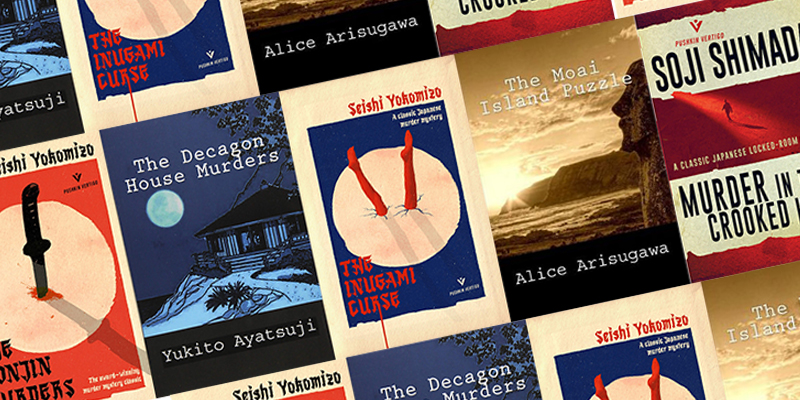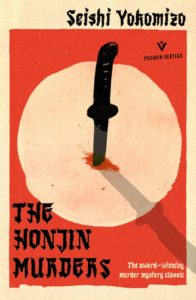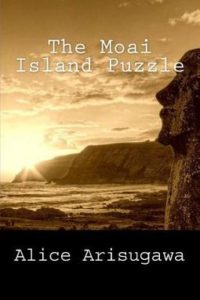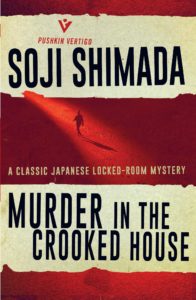Kosuke Kindaichi is in his mid-twenties. He steps off the train from Tokyo and onto the fictional page wearing a traditional haori jacket and kimono, hakama skirt, tabi socks and wooden clogs. The patterns on the different items of clothing clash, the fabrics are worn and wrinkled, there are holes in the toes of his socks and his jacket bulges with the many notebooks he’s crammed into it. Perhaps these are not unusual sartorial choices in Japan circa 1945, the author assures us that similarly dressed young men can be spotted on the streets of Kyoto, but they definitely signal a lack of vanity (and fashion) in this one. His hair is a rat’s nest under the wide-brimmed hat he wears, due to his habit of scratching his head violently when he’s excited. To complete the picture, it’s worth noting that he carries a walking stick and, we will soon learn, speaks with a stutter.
Kindaichi is the eccentric creation of the Japanese writer Seishi Yokomizo and he will go on to star in seventy-seven mystery novels of the variety known as honkaku. Honkaku, and its successors shin honkaku, are carefully constructed three-dimensional puzzle mysteries inspired by the Golden Age of Western detective fiction. Most include some form of the classic locked-room dilemma. Those who write in this style abide by “fair play” rules, which requires that all clues necessary for the reader to solve the crime be present in the text, as dictated in 1923 by S.S. Van Dine in his Twenty Rules for Writing Detective Stories. Pushkin Press has publishing two of Seishi Yokomizo’s novels this summer as part of their Vertigo Collection. The Honjin Murders and The Inugami Curse will be English readers’ introduction to this acknowledged master of the form and his detective.
Honkaku, which roughly translates to mean “orthodox” in English (shin honkaku means “new orthodox”), is not just a word but a concept. Shimada Soji, author of The Tokyo Zodiac Killings and evangelist of the sub-genre, has written introductions to several of these novels that explain the origin of the form. According to Shimada, honkaku mysteries are detective stories that are “not only literature but also, to a greater or lesser extent, a game.” Imagine a more complex version of the Encyclopedia Brown, Boy Detective series, in which the solutions are dependent not so much on spotting inconsistencies in the plot (Brown’s specialty) as they are on solving the physical mechanics behind the actual crime. To this end, honkaku books usually include diagrams, floor plans, and maps that, while crudely drawn, are useful in keeping track of the particulars of the crime. And a list of the characters, which make up the pool of potential suspects and victims, always precedes chapter one. The crimes are dizzyingly complex, frequently relying on a Rube Goldbergian mechanical component that is all but impossible for the reader to reverse engineer.
The Honjin Murders, originally serialized in a Japanese magazine in 1946, marks the first appearance of Kosuke Kindaichi. Kindaichi is summoned by his mentor to solve the murder of the man’s beloved niece. The young woman and her husband were killed on their wedding night, brutally slashed and stabbed with a katana sword. Alerted by the strange sound of someone playing the koto in the early hours—a musical instrument that is significant to the groom’s family and played with the aid of claw-like finger picks—the bodies are discovered in a locked bedroom. Several strange clues are left at the crime scene and everyone, at one time or another, is a suspect. Set in postwar Japan (the setting of many honkaku and shin honkaku mysteries), and narrated in a casually chatty voice, there is a retro, pre-code Hollywood, air to the story.
More than simple mysteries, honkaku novels are love letters to the genre. The authors were fans, first, and frequently pay homage to their heroes—writers like Agatha Christie, John Dickson Carr, S.S. Van Dine, Ellery Queen, and the grandfather of Japanese detective fiction, Edogawa Rampo (whose work is still frustratingly difficult to find in English). They are members of the Kyoto University Mystery Club and the Honkaku Mystery Writers of Japan.

The characters they populate their stories with are also avid fans, with huge collections of mystery paperbacks, and membership cards to their own fictional university mystery clubs. Some even go by nicknames based on their favorite writers, a device which features prominently in the plot of Yukito Ayatsuji’s The Decagon House Murders.
Sometimes the action will pause for a several pages, to allow for conversations criticizing the “social school” of mystery writing, obsessed with criminal psychology and motive, and its obvious inferiority to the honkaku style. Or, as in Alice Arisugawa’s The Maori Island Puzzle, to discuss the problem locked rooms pose a writer. Everyone, on the page and off, is fully conscious of the artificiality of the setting and situation they find themselves in, which adds a subtle and unexpected meta component into the narrative. It’s not uncommon the narrator, a few pages before all is revealed, to break the fourth wall and challenge the reader to solve the case on their own.
Stripped down prose, prioritizing information over style, is the norm. And so is the inclusion of almost comically lurid details, like a WWII veteran who hides his face behind a creepy mask, a seductive Yakuza moll with full body tattoos, a mad alchemist attempting to build his own Frankenstein monster, and at least two islands cut off from the mainland by storms. In Soji Shimada’s Murder in the Crooked House the setting is the home of a wealthy businessman, built so that all the floors slope at a five-degree angle. The gimmick might seem a bit silly at first, which it is, but Shimada is fully committed to the madness of his architectural design, going so far as to provide a three-dimensional diagram of the space. The way it fits into the plot, because of course it does, is absolute genius.
Yokomizo’s The Inugami Curse was written and published several years after The Honjin Murders, and after the character of Kosuke Kindaichi had been established in the audience’s imagination. The patriarch of a wealthy family dies and his descendants gather, impatiently, for the reading of the will. Kindaichi arrives on the scene, hired by the family’s attorney, only to learn that his employer has been killed. Intrigued, he stays on to see what unfolds. What follows is a series of horrible and elaborately staged murders, as the heirs to the Inugami fortune—and curse—are dispatched, one-by-one. Narrated by the same chatty, unnamed storyteller we encountered in The Honjin Murders, who acts as an invisible foil to Detective Kindaichi and addresses to the reader with easy familiarity, The Inugami Curse has a more convoluted plotline than the earlier book, which moves away from the of the locked room scenario.
If Yokomizo’s books have flaw, it is that they preserve the social mores and prejudices of the era in which they were written. Homosexuality and female promiscuity are represented as scandalous behaviors, though no actual moral judgements or declarations are put down on the page. The tone of the writing is overall more old-fashioned than you’ll find int the shin honkaku mysteries of the 1970’s and 80’s, which are more readily available in English. But the puzzles Yokomizo created remain among the cleverest and engaging—and still present a real challenge to modern readers. They are a wonderful introduction to this style of Japanese Crime fiction.
The emergence of the hard-boiled detective fiction of Raymond Chandler and his ilk mark the dividing line between honkaku and shin honkaku. The trend towards social realism, disparaged in The Decagon House Murders, signaled a temporary hiatus for this style of mystery. But it returned in the 1970’s and, thanks to a number of small, specialized publishers, has been preserved and made available to a new generation of fans.
Below is a list of ten titles available in English, a mix of honkaku and shin honkaku mysteries, in no particular order.
1. The Decagon House Murders by Yukito Ayatsuji, translated by Ho-Ling Wong
2. Inspector Imanishi Investigates by Seicho Matsumato, translated by Beth Carey
3. The Inugami Curse by Seishi Yokomizo, translated by Louise Heal Kawai
4. The Moari Island Puzzle by Alice Arisugawa, translated by Ho-Ling Wong
5. The Tattoo Murder Case by Akimitsu Takagi, translated by Deborah Boehm
6. The Tokyo Zodiac Killings by Soji Shimada, translated by Ross and Shika Mackenzie
7. Murder in the Crooked House by Soji Shimada, Louise Heal Kawai
8. The Honjin Murders by Seishi Yokomizo, translated by Louise Heal Kawai
9. Devils in Daylight by Junichiro Tanizaki, translated by J. Keith Vincent
10. The Early Cases of Akechi Kogoro by Rampo Edogawa, translated by William Varteresian





















